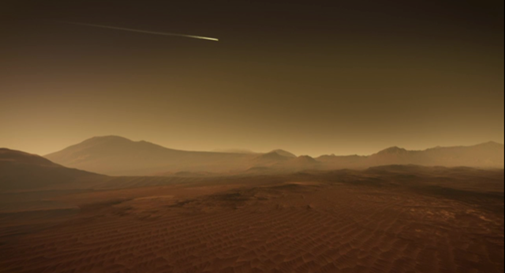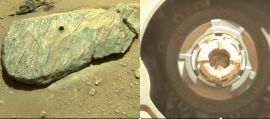Il rover Perseverance della NASA atterra su Marte!
Dopo aver completato un viaggio di 472 milioni di km (293 milioni di miglia) dalla Terra, il rover più sofisticato dell'umanità, Perseverance, è atterrato con successo sulla superficie di Marte
| Richard Brewer |

Illustrazione resa disponibile dalla NASA / JPL
RUBRICA - Dopo aver completato un viaggio di 472 milioni di km (293 milioni di miglia) dalla Terra, il rover più sofisticato dell'umanità, Perseverance, è atterrato con successo sulla superficie di Marte ai margini dell'antico delta del fiume scomparso da tempo e del letto del lago del cratere Jezero pronto per iniziare operazioni e ricerca di segni di vita microbica fossilizzata.
Giovedì, 18 febbraio 2021 12:49 PST (21:49 CET) La NASA ha ricevuto il segnale che Perseverance era entrata nell'atmosfera di Marte ... undici minuti prima, guardando a ovest dal cratere Jezero al di sopra del deposito delta a forma di ventaglio e nel cielo sopra la valle che attraversa il bordo del cratere, un fiammeggiante messaggero dalla Terra entra nell'atmosfera superiore e attraversa l'orizzonte. Ad un'altitudine di 131 km, dista 636 km dal sito di atterraggio e si muove a 19.202 km / h, il Perseverance MARS rover della NASA ha iniziato il suo avvicinamento all'atterraggio nel sito più difficile di sempre tentata. Quando il veicolo spaziale entra nell'atmosfera marziana, viene rallentato dalla resistenza e dall'attrito mentre si riscalda drasticamente. La temperatura sulla superficie esterna dello scudo termico raggiunge circa 1.300 gradi Celsius. Il touchdown in superficie sarà tra sei minuti e 49 secondi.
A causa del ritardo di comunicazione di 11 minuti tra la Terra e Marte, la sequenza di atterraggio degli eventi che seguirono l'ingresso nell'atmosfera è stata avviata e controllata autonomamente dalla navicella senza alcun input dalla sala di controllo della missione terrestre presso il Jet Propulsion Laboratory (JPL) di Pasadena , California.
Ad un'altitudine di circa 11 km a una velocità di 1.512 km / h, è stato schierato il più grande paracadute supersonico mai inviato su un altro pianeta. L'enorme paracadute di 21,5 metri di diametro, si è aperto in meno di un secondo in condizioni violente che avrebbero potuto distruggerlo e ha fornito un passaggio cruciale necessario per rallentare ulteriormente il veicolo.
Quando ha raggiunto un'altitudine di 9,7 km, 10,5 km dal sito di atterraggio e ad una velocità di 584 km / h ... due minuti e 25 secondi dall'atterraggio lo scudo termico è stato separato, esponendo il rover all'atmosfera marziana. Telecamere e strumenti hanno iniziato a raccogliere dati.
Nella sottile atmosfera marziana, il paracadute è in grado di rallentare il veicolo solo a circa 320 chilometri all'ora. Per raggiungere la sua sicura velocità di atterraggio, Perseverance si è liberato dal paracadute e ha guidato il resto del percorso usando i razzi.
Ad un'altitudine di 3,7 km e una velocità di 313 km / h il computer di bordo ha trovato un'area sicura priva di pericoli in cui atterrare. Ora a soli 3,7 km dal sito di atterraggio, l'atterraggio è in un minuto e 18 secondi.
Il rover e il suo motore di discesa a razzo, dopo essersi staccati dal paracadute, iniziarono a volare sopra la superficie della valle per ridurre la sua velocità verticale ed eliminare qualsiasi velocità orizzontale. Touchdown in un minuto.
21,3 m dal luogo di atterraggio e 21 m dal suolo, metà dei motori si è spenta e la fase di discesa si è stabilizzata per raggiungere una velocità finale di 2,69 km / h, un atterraggio confortevole velocità. Touchdown in 18 secondi.
Ad un'altitudine di 20 m il rover è stato rilasciato dalla fase di discesa su una serie di cavi di nylon che si estendevano per 6,1 m verso il basso. La combinazione della fase di discesa con il rover sospeso al di sotto è scesa lentamente insieme. Quando il rover ha percepito che le sue ruote avevano toccato il suolo, ha tagliato i cavi e ha liberato la fase di discesa per volare a una distanza di sicurezza dove ha fatto il suo atterraggio incontrollato (crash). Un segnale di touchdown è stato inviato sulla Terra alle 12:45 PST (21:45 CET) dichiarando l'atterraggio sicuro del rover.
Undici minuti dopo, alle 12:56 pm PST (21:56 CET), i terrestri hanno ricevuto la notizia e si sono lasciati sfuggire un esuberante applauso e un sospiro di sollievo. Atterraggio completato. Perseverance, il rover più sofisticato dell'umanità è al sicuro sulla superficie di Marte pronto per iniziare operazioni della durata di almeno due anni e per la prima volta in 40 anni, alla ricerca diretta di segni di antica vita microbica. È atterrato sul suolo marziano ai margini di un antico delta del fiume scomparso da tempo e del letto del lago all'interno del cratere da impatto Jezero largo 45 km appena a nord dell'equatore marziano, un luogo considerato uno dei luoghi più ideali per trovare prove dell'antica vita microbica. La domanda principale a cui Perseverance sta cercando di rispondere è: c'è mai stata vita antica su Marte? Per rispondere a questa domanda, il rover raccoglierà e conserverà campioni di roccia e suolo scelti con cura per il ritorno sulla Terra durante una missione successiva. Se la vita esistesse in un luogo diverso dalla Terra nel nostro sistema solare, è probabile che potremmo trovarne prove qui su Marte, sull'antica riva del lago del cratere Jezero.

Illustrazione resa disponibile dalla NASA / JPL
******************** IN ENGLISH ***********************
NASA’s Perseverance rover lands on Mars!
After completing a 472 million km (293 million mile) voyage from Earth, humanity’s most sophisticated rover, Perseverance, successfully landed on the surface of Mars at the edge of the ancient, long-vanished river delta and lake bed of Jezero Crater ready to begin operations and search for signs of fossilized microbial life.
Thursday, 18 February 2021 12:49 pm PST (21:49 CET) NASA received the signal Perseverance had entered the atmosphere of Mars ... eleven minutes earlier, looking west from the Jezero crater out over the fan shaped delta deposit and into the sky above the valley that cuts through the crater rim, a fiery messenger from Earth enters the upper atmosphere and streaks across the horizon. At an altitude of 81 miles it is 395 miles from the landing site and moving at 11,932 mph, NASA’s Perseverance MARS rover has begun its approach to land in the most difficult site ever attempted. As the spacecraft enters the Martian atmosphere it is slowed down by drag and friction while drastically heating up. The temperature at the external surface of the heat shield reaches about 1,300 degrees Celsius (2,370 degrees Fahrenheit). Touchdown on the surface will be in six minutes and 49 seconds.
Due to the communication delay of 11 minutes between Earth and Mars, the landing sequence of events that followed entry into the atmosphere were initiated and controlled autonomously by the spacecraft with no input from Earth’s mission control room at the Jet Propulsion Laboratory (JPL) in Pasadena, California.
At an altitude of about 7 miles, at a velocity of 940 mph, the largest supersonic parachute ever sent to another planet was deployed. The enormous parachute 70.5 feet in diameter, opened in less than a second under violent conditions that could have shredded it and provided a crucial step required to slow the vehicle down further.
As it reached an altitude of 6 miles, 6.5 miles from the landing site and at a velocity of 363 mph … two minutes and 25 seconds from touchdown, the heat shield was separated and dropped away exposing the rover to the Martian atmosphere. Cameras and instruments began taking data.
In the thin Martian atmosphere, the parachute is only able to slow the vehicle to about 200 miles per hour. To get to its safe touchdown speed, Perseverance cut itself free of the parachute, and rode the rest of the way down using rockets.
At an altitude of 2.3 miles and a velocity of 195 mph the onboard computer found a safe area free of hazards in which to land. Now only 2.3 miles from the landing site, touchdown is one minute and 18 seconds away.
The rover and its rocket powered descent engine, having detached from the parachute, began flying above the valley surface to reduce its vertical velocity and eliminate any horizontal velocity. Touchdown in one minute.
70 feet from the landing site and 69 feet above the ground, half the engines turned off and the descent stage leveled off to reach a final velocity of 1.67 mph, a comfortable landing speed. Touchdown in 18 seconds.
At an altitude of 66 feet the rover was released from the descent stage on a set of nylon cables that extended 20 feet down. The combination of descent stage with rover hanging beneath slowly descended together. When the rover sensed its wheels had touched the ground it cut the cables and freed the descent stage to fly off to a safe distance away where it made its own uncontrolled (crash) landing. A touchdown signal was sent to Earth at 12:45 pm PST (21:45 CET) declaring the rover's safe landing.
Eleven minutes later, at 12:56 pm PST (21:56 CET), Earthlings received the news and let out an exuberant cheer and a sigh of relief. Landing complete. Perseverance, humanity’s most sophisticated rover is safely on the surface of Mars ready to begin operations lasting at least two years and for the first time in 40 years, directly search for signs of ancient microbial life. It landed on Martian soil at the edge of an ancient, long-vanished river delta and lake bed inside the 28 mile wide Jezero impact crater just north of the Martian equator, a location considered to be one of the most ideal places to find evidence of ancient microbial life. The main question Perseverance is trying to answer is: Was there ever ancient life on Mars? To answer that question, the rover will collect and store carefully chosen rock and soil samples for return to Earth during a follow on mission. If life existed anywhere other than Earth in our solar system, chances are we may find evidence of it here on Mars at the Jezero crater’s ancient lakeshore.























